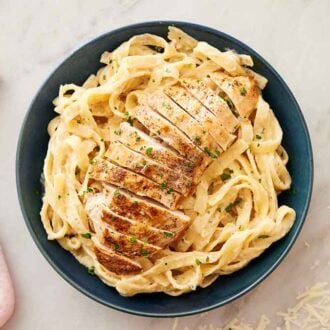
Chicken Alfredo Recipe
Homemade Chicken Alfredo comes together in just 30 minutes with simple ingredients. Perfect for busy weeknights!
Servings 6 servings
Calories 913kcal
Equipment
- Large Pot
- Large skillet
Ingredients
- 1 (16-ounce/454g) package fettuccine pasta
- 1 pound boneless, skinless chicken breasts (halved crosswise if very thick) (450g)
- ¾ teaspoon salt
- ¼ teaspoon ground black pepper
- 2 tablespoons olive oil
- 1 tablespoon unsalted butter
For the Sauce:
- 2 cups heavy cream (480mL)
- ½ cup unsalted butter cubed (113g)
- 3 cloves garlic minced (about 1 tablespoon minced)
- ½ teaspoon salt
- ½ teaspoon ground black pepper
- 1 cup grated parmesan cheese (90g)
- Chopped fresh parsley for garnish
Instructions
- Bring a large pot of salted water to a boil over medium-high.
- While the water is coming to a boil, season the chicken with salt and pepper.
- Heat the oil and butter in a large skillet over medium-high heat. Add the chicken, and cook until browned on both sides, about 7 to 9 minutes per side, and a thermometer inserted in the thickest part of each piece registers 165°F. Remove from skillet and cover to keep warm. Wipe the skillet clean.
- Add the pasta to the boiling water, and cook according to the package directions. Drain well, reserving ½ cup of the cooking water. Keep warm.
For the Sauce:
- While the pasta is cooking, combine the cream, butter, and garlic in the same skillet as you cooked the chicken. Cook over medium heat, whisking often until the butter is melted. Whisk in the salt and pepper. Bring to a low simmer. Cook, whisking constantly until slightly thickened, about 5 minutes, and adjust the heat as needed to keep the sauce from boiling.
- Gradually whisk in parmesan cheese until smooth. Remove from heat. Add the cooked pasta. Toss to coat, adding a bit of reserved cooking water as needed to thin the sauce.
- Slice the chicken breasts into ½-inch-thick strips. Divide the pasta among bowls, top with the sliced chicken, and garnish with parsley.
Video
Notes
- To keep the sauce from boiling, adjust the heat on your burner as needed. Your stove may run hotter than mine and needs lower heat. You want the sauce to gently bubble, so turn the burner as low as necessary.
- If you toss the pasta with the sauce and it ends up sitting for a while before serving, turning thick or sticky, stir in a few splashes of warm pasta water, milk, cream, or even chicken broth to loosen the sauce back up.
Nutrition
Calories: 913kcal | Carbohydrates: 59g | Protein: 34g | Fat: 61g | Saturated Fat: 34g | Polyunsaturated Fat: 4g | Monounsaturated Fat: 18g | Trans Fat: 1g | Cholesterol: 262mg | Sodium: 904mg | Potassium: 585mg | Fiber: 3g | Sugar: 4g | Vitamin A: 1912IU | Vitamin C: 2mg | Calcium: 239mg | Iron: 2mg